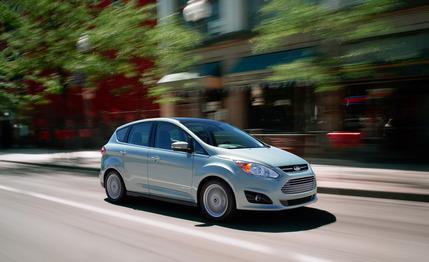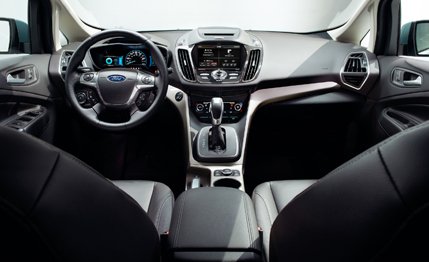 First Drive Review
First Drive Review
After watching Toyota build itself a solid business with the Prius—more than 136,000 sold last year in the U.S.—Ford is one Detroit automaker finally getting serious about hybrids. It has plucked the C-Max people mover from its European lineup, given it the twice-over to meet the U.S.’s strangely unique crash standards, and endowed it with a revamped version of the powertrain from the now-defunct Ford Escape hybrid. Two models are headed to dealerships: the C-Max hybrid in September and, a few months later, the plug-in C-Max Energi with a larger battery pack for more electric-only driving.
In Europe, Ford sells the C-Max—it’s basically a tall wagon version of the Ford Focus—with a choice of two gasoline engines and two diesels. But Ford wants Americans to associate the C-Max exclusively with hybrid technology, so the C-Max will come to these shores only as a hybrid, with fuel-economy ratings of 47 mpg in the city and 47 mpg on the highway. Senior engineer John Davis says it’s about building a brand, similar to what Toyota has with Prius (recall that three cars are sold under the Prius name: the familiar Prius hatchback, the wagonlike Prius V, and the compact Prius C.
C-Max Is to Hybrid as Prius Is to, Well, Hybrid
The C-Max’s base pricing is aggressive; the SE starts at $25,995. The trimmed-up SEL with leather, keyless start, and the MyFord Touch system leaves the blocks at $28,995. Those prices slot the C-Max between the base Prius and Prius V in an apparent strategy to divide and conquer. Stand-alone options include a bunch of entertainment and convenience packages ranging from $570 to $3080—the latter of which is available only on the SEL and includes a hands-free, motorized liftgate; active parking; a rear camera; and a nine-speaker Sony audio system—an $1195 panoramic glass roof, and a few special colors. Go heavy on the C-Max order sheet, and you can get the price up past $33,000.

The general basics of the C-Max’s hybrid system are the same as those of the old Escape and the Prius. The gasoline engine works in tandem with a two-motor, continuously variable planetary-gear transmission that uses one electric motor to provide traction power to the wheels and one motor to change the transmission’s modes. But instead of a 2.5-liter Atkinson-cycle four-cylinder as in the old Escape, the C-Max uses a 2.0-liter that now works with a transmission modified and built in-house at Ford’s transmission plant in Sterling Heights, Michigan, rather than sourced from Toyota supplier Aisin. And instead of more-conventional nickel-metal hydride batteries, the C-Max’s battery is a compact, air-cooled 1.6-kWh lithium-ion pack mounted under the cargo-area floor and comprised of dozens of cylindrical cells from Korea’s Sanyo Corporation. The power electronics and the software controls are all blue oval.
Final assembly happens on the shared Focus line at Ford’s assembly plant in Wayne, Michigan, and the finished product, despite a rotund 3600-pound curb weight, is very Continental-feeling and Focus-like on the road. The steering is firm and connected with a strong on-center feel, and the body stiffness is outstanding. Bumps get soaked up and dissipated in the stout structure, the rolling and pitching by the tall body are tightly damped, and the brakes are activated via a firm pedal. Moreover, the 188-hp combined output of the system produces a lively throttle response and a distinct kittenish growl from up front.